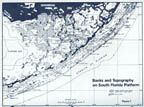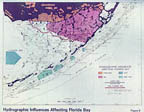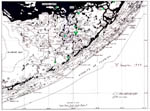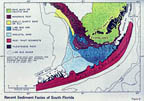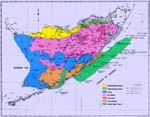|
Hydrographic Influences of Florida Bay:
The water of Florida Bay and the Bay biota
are derived from three sources: the Gulf of Mexico to the west, the
Reef Tract to the south and east, and the Everglades to the north (Fig.
2). In addition to the external hydrographic influences, Florida
Bay exerts a certain amount of influence to itself with distinctive
characteristics.
1) Gulf Influence:
The Gulf has the greatest hydrographic influence
in Florida Bay. Gulf water does not have unrestricted access to the
Bay because of broad carbonate mud banks in western Florida Bay that
restrict diurnal tidal action to the extent that much of central and
northeastern Florida Bay is without tides. Significant gaps in the carbonate
mud banks allow the Gulf waters to spread across the Bay.
2) Reef Tract Influence:
The surface water temperatures for the Reef
Tract range from 59° to 91°F. The circulation is open and there
is semi-diurnal tide exchange with Florida current. The depth range
is 0 to 300 feet and the turbidity (relative amount of sediment in the
water) is periodically high in the lagoonal sections.
Waters from the Reef Tract penetrate Florida
Bay mainly through openings between the Keys. In addition, there is
some passage through the porous limestones of the Keys themselves. The
principal effects of the Reef Tract waters appear in the area southwest
of Lower Matecumbe Key (Fig. 1). The Reef Tract
influence is greatest opposite the wide gaps in the rock Keys. The waters
from the reef tract are also of normal marine type and are subject to
daily tidal exchange.
The reef tract fauna contains many more large
species and has greater species diversity than the Bay fauna. The discovery
of large corals, Queen Conchs, sea urchins, starfish, sponges, sea fans,
sea whips, and sea pens (Fig. 7) all reflect Reef
Tract influence in the Bay. Most of the Reef Tract species disappear
from the bay a short distance from the Keys.
3) Everglades Influence:
Fresh water accumulates in the Everglades between
May and October when water levels in Florida Bay tend to be high. When
the water level of Florida Bay drops at the end of the year, the freshwater
from the Everglades flows southward into the Bay. This cycle suggests
that on the northern edge of Florida Bay salinities may range from as
little as 10°/oo during the winter outflow
to as much as 50°/oo during the late summer.
Organisms that can tolerate variable salinity (euryhaline biota) are
found on the northern edge of Florida Bay, where organisms that cannot
tolerate variable salinity (stenohaline biota) are found closer to the
open ocean. The euryhaline biota have low diversity
and high abundance, while the stenohaline biota
have high diversity and low abundance.
4) Bay "Influence":
The surface water temperatures in Florida Bay
range from 59° to 104°F. The circulation is restricted with
periodic tides occurring only on the boundaries. The depth range is
0 to 10 feet and the turbidity is generally high.
Overall, the waters of the Bay interior are
characteristically variable in salinity. The lower end of the range
is apparently not as low as the bordering region of the Everglades;
perhaps 20°/oo rather than 10°/oo. However, salinity levels
may still rise to levels of 35 or 50°/oo. The low salinity levels
are due to the influence of the Everglades, while the high salinity
levels are due to excess evaporation over replenishment during the hot
summer months. Thus, high salinities are an indigenous Bay environmental
characteristic.
The high salinity levels would not be maintained
if there were adequate mixing with either the Gulf or Reef Tract areas.
However, mixing does not occur due to sluggish circulation and lack
of tides in the Bay interior. Partial stagnation of the water parallels
the high salinities and is the second distinctive characteristic of
the Bay influence.
|

